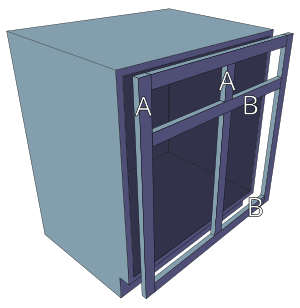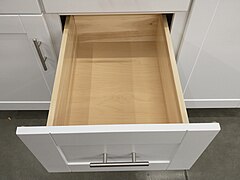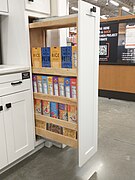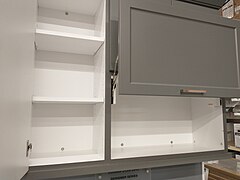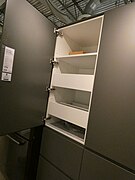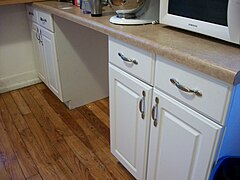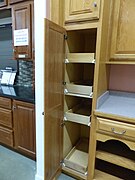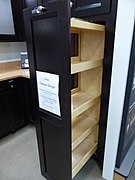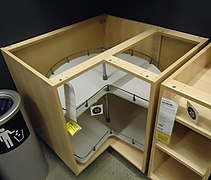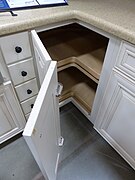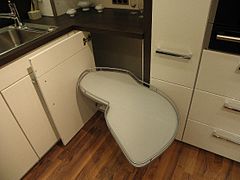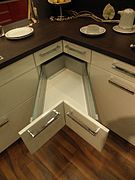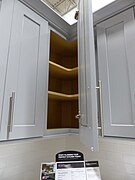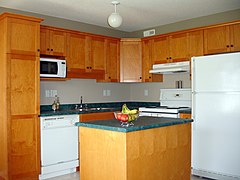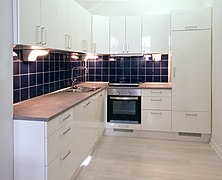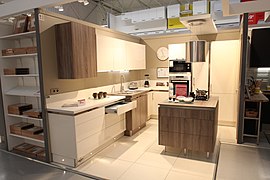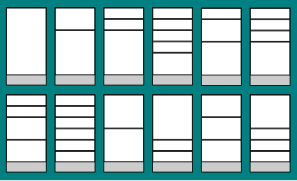Kitchen Remodel/Cabinet theory
|
In this chapter, I would like to give some general information about cabinets. There are many differences between individual products, some cater to different tastes, others have practical relevance. I will omit the material question (which is mostly a matter of budget and personal taste) and go directly into details of furniture structure. The intention of this chapter is to help you to become more aware of what you personally expect from a kitchen, which will make it easier for you to decide for or against individual products.
Anatomy
[edit | edit source]Face frames
[edit | edit source]All have in common that they are built with a face frame, which is an optional element in cabinetry, but a very characteristic one in the United States until today, notably with kitchen cabinets. Although it is widely believed that a face frame makes a kitchen cabinet more sturdy, I presume that the actual reason for the perennial popularity is the specific appearance. The face frame adds a look to a cabinet that is both traditional and dapper, and homey.
While most face frames today are rather minimalist, they used to be a subject to elaborate embellishment. A decoration that can still be found today, if rarely, is beading to the inner edges (second image, A; this will only go together with inset drawers and doors) or chamfering to the outer edges of stiles (B). Historically, there was much more going on in cabinetry, with elements like decorated end panels and base moulding among others (C, D, E).
Even without any ornamentation at all, a face frame will offer an opportunity to show of precious materials like solid wood.

But hand on heart: A face frame wants to be shown off. What is it worth in conjunction with full overlay drawers and doors?
Framed vs. frameless cabinets
[edit | edit source]
In the United States, kitchen cabinets are traditionally framed cabinets. That means they have an additional "face frame" sitting on the front of the cabinet box, with individual cutouts for drawers and doors. The framing provides those cabinets with a specific rustic, solid and homely look that many Americans prefer over the more clean, cool and modern international style. The only reported and undisputed advantage of framed cabinets is that due to their additional layer of material they endure transportation easier. Allegedly, framed cabinets also allow for an easier adjustment of doors and drawers, but I believe that is not a matter of framed or frameless, but directly depends on the quality of the hinges and drawers. Ikea's Maximera drawers for example, which are conceived for frameless cabinets, feature an adjustment mechanism that is quite sophisticated. With frameless cabinets, you also may need more filler pieces than with framed ones, but that depends on the product and on your layout. I will go more into detail about filler pieces in a later chapter when I'll describe cabinet installation.
In the U. S., the cheapest manufacturer of framed cabinets is probably KraftMaid. For my first kitchen remodel, a decade ago, I chose KraftMaid cabinets and found the quality and the bandwidth of options quite decent. Unfortunately, KraftMaid don't make a big display of what they can do on their web site, so you'll have to find a retailer with a large showroom and get in touch with that retailer's kitchen designer. My local Home Depot for example only shows a fraction of the possibilities that this manufacturer offers. If you are either on a very tight budget or are really aiming for historic authenticity, another interesting option is to use reclaimed cabinets.
-
framed base cabinet with open drawer
-
framed base cabinet with nested drawers
-
framed wall cabinet with shelves behind a door
-
framed wall cabinet with shelves behind a double door
-
framed high cabinet with a pullout
The most important advantage of frameless cabinets is that they make much better use of the space within the cabinet box. Frameless cabinet boxes allow for wider and higher drawer boxes. Cabinets with shelves have neither rims nor mid-stiles and are therefore fully accessible. Some U. S. based producers offer both framed and frameless cabinets; among those are Hampton Bay and Wellborn. But the most affordable manufacturer anywhere in the world is probably Ikea. One of their top assets in my opinion is their web site which does not only show literally all of their products (with prices), down to the most ancillary filler piece, but also gives you exact dimensions and detailed instructions for assembling; the latter are extremely helpful if you want to understand the anatomy of those cabinets and their possibilities, before you commit to a purchase.
-
frameless base cabinet with open drawer
-
frameless base cabinet with nested drawers
-
frameless wall cabinets with shelves behind doors
-
frameless wall cabinet with shelves behind a double door
-
frameless high cabinet with shelves and drawers behind a door
Toe kicks vs. legs
[edit | edit source]
High and base cabinets usually have a toe kick, that is a slightly recessed base. Toe kicks are typically 4 inches (10 cm) high and recessed 3 inches (7.5 cm). The height addition is necessary to align the cabinet's upper edge cabinet with that of other elements, like a ranges or a dishwasher. The recess provides extra space for the feet of the people who stand in front of the cabinet. If the cabinet is serves merely decorative purposes the recess can be omitted.
High and base cabinets come either with or without an integrated toe kick. If they come without one, you can choose between a number of options for how you want to bring your cabinets up to standard height: with a separate toe kick, with a toe kick valance (an arch-like element) or with legs. All three of those elements are available in all sorts of different styles and designs.
What customers prefer, is mostly a matter of taste and of what matches the cabinet style. At this point, I would only like to make a few remarks about legs:
There a three obvious disadvantages of the use of legs:
- If the space below cabinets is kept open, dust and dirt and even scraps of food will collect down there. The area is inconvenient to reach and not easy to clean.
- Entire-room flooring will be mandatory.
- Regular toe kicks probably make a sturdier cabinet foundation than most legs. But: If you add clip-on toe kicks so that the space under the cabinets is well concealed, you can install additional support. For inspiration you can check out the adjustable brackets that Ikea offer (product # 002.984.06).
There are also advantages of legs:
- Adjustable legs make the cabinet installation much each easier than regular toe kicks, especially for do-it-yourselfers. If you use traditional toe kicks you'll need to shim those in order to get the cabinet level. But with adjustable legs, you just twist the legs until the cabinet is all horizontal.
- Legs make the space under the cabinets accessible. If you conceal it with clip-on toe kicks, you can use that space to feed electric or water connections to your appliances. Some people even use it for toe-kick drawers.
Types of cabinets
[edit | edit source]
There are obviously base cabinets, wall cabinets, and high cabinets on the market. Another important differentiation is that between regular cabinets, corner cabinets and outside corner cabinets. Many manufacturers offer only very limited choices in corner cabinets and no outside corner cabinets at all. Sometimes there are smart ways to improvise, but if that is not possible the only option may be to pick another manufacturer.
Cabinet space organization
[edit | edit source]The deeper a cabinet is (and the more fuzzy you are with not wasting space or control), the more important is cabinet space organization.
Regular cabinets
[edit | edit source]One advantage of shelves over drawers is that it is easy to mount them with custom spacing. Even if the pre-drilled holes that hold the shelf-supports turn out to not be quite in the perfect height for your needs, you can drill your own holes. And the greatest advantage of all is that shelves is are cheap.
But unless a cabinet has only little depth, shelves make it difficult to overlook their content.
In most cases, drawers make it much easier to find stuff in a cabinet. With modern slides and soft-close feature, drawers also run so smoothly that they are suitable not only for pots and pans, but even for tableware. Consider having drawers not just up to countertop height, but up to the height of the chin of the shortest grown-up person in your household (but keep in mind that adults lose body length as they age).
The only disadvantage of drawers, apart from the costs, is that it can be more difficult than with shelves to install them with custom spacing. In particular with framed cabinets, you will possibly get what you get and won't have the choice to space your drawers – I mean down to the inch or even half inch – like you really would like then. If custom spacing is important to you, you can check out either frameless cabinets (which in some cases give you much more flexibility than framed cabinets) or cabinets with drawers that lie behind a door.
Drawers behind a door (like nested drawers) are a little more awkward to access than normal drawers. The immediate vicinity of work places like a cooktop or your prime cabinet for everyday utensils are certainly not the best locations for those. But since they offer flexible installation and as many subsequent changes as you may want, drawers behind doors are probably ideal for food storage, unless you have a walk-in pantry where you don't care about the appearance of your cabinet fronts and omit those doors altogether anyways.
A very cool third option that also works for high cabinets or wall cabinets are pull-outs. Make sure that you put those in positions where you have full access to both sides of the apparatus (left and right) when it is pulled out. A pull-out that is installed at the end of a cabinet row – adjacent to a wall or a corner cabinet – may not be very helpful. Also make sure that you purchase a pull-out that is adjustable in terms of custom spacing of the shelves. You also may or may not want to request additional shelves.
-
shelves in a wall cabinet
-
shelves behind doors can be combined with open shelves
-
open shelving for wine bottles
-
shelves can even be mobile
-
shelves are often combined with drawers in one cabinet frame
-
drawers
-
interior drawers in a base cabinet
-
interior drawers in a high cabinet (framed)
-
interior drawers in a high cabinet (frameless)
-
a very skinny pull-out in a base cabinet
-
pull-out for cutting boards
-
pull-out for garbage bins
-
pull-out in a high cabinet; notice that it doesn't go all the way up
-
European pull-out, turnable
Corner cabinets
[edit | edit source]
Corner cabinets are notoriously inefficient in terms of use of space. If a corner cabinet cannot be avoided, the most sensible use that can be made of it is installation of shelves for long-term storage of things that you plan virtually never to access; only what is directly behind the door can be conveniently reached. The second best option are half shelves in L-shape (see image); to reach those requires some mild gymnastics, but they have an efficiency of whopping 80 %. A full Lazy Susan uses ~65 % of the area while a 3/4 Lazy Susan has an efficiency of only ~50 %. The worst of all corner cabinet solutions are probably diagonal drawers because they only use roughly a third of the available space.
By the way, corner pull-outs are even worse than Lazy Susans; I did the math for Ikea's corner base cabinet pull-out fitting (Utrusta series; I own one): it has a space efficiency of only 35 %. I very much doubt that any comparable product reaches a much higher figure.
-
3/4 Lazy Susan in a base cabinet
-
3/4 Lazy Susan with folding door
-
Full Lazy Susan in a base cabinet
-
Lazy Susan for garbage bins
-
Corner cabinet pull-out
-
Corner cabinet pull-out, Le Mans style
-
Corner cabinet drawer
-
Lazy Susan in a corner wall cabinet
-
Standard corner wall cabinet
Cabinet front composition
[edit | edit source]Another important criteria that needs to be considered when choosing a kitchen manufacturer is their philosophy of kitchen front appearance. It is understood that most manufacturers offer large selections of different front designs. But in this section I am not referring to different door styles or materials or colors, but to different ways how those front elements (drawer fronts and doors) are combined and add up to a kitchen front view that ideally is beautiful and well composed.
Are you aiming for clear, uniform fronts with all horizontal elements perfectly aligned, or do you seek something organic and cheerful and therefore don't mind irregularities?
-
Kitchen with uniform fronts
-
Kitchen with uniform fronts
-
Notice that the elements in this base cabinet front are not horizontally aligned.
-
Another messy base cabinet front composition
-
Here they don't match either, but since they are aligned, it still looks well organized.
-
Another example for a casual composition that appears rather playful than desultory
-
The wall cabinets in this kitchen have four different heights!
-
Kitchen with uniform wall cabinet fronts (well, perhaps a bit boring)
-
This kitchen features varied wall cabinets for aesthetic reasons.
-
Different front colors on wall cabinets and base cabinets
Different manufacturers offer different front schemes. Two examples:
-
While KraftMaid are very flexible in cabinet dimensions, they are very restricted in their base cabinet front schemes.
-
Ikea's cabinet system "Sektion" in contrast facilitates dozens of iterations; here some examples.

